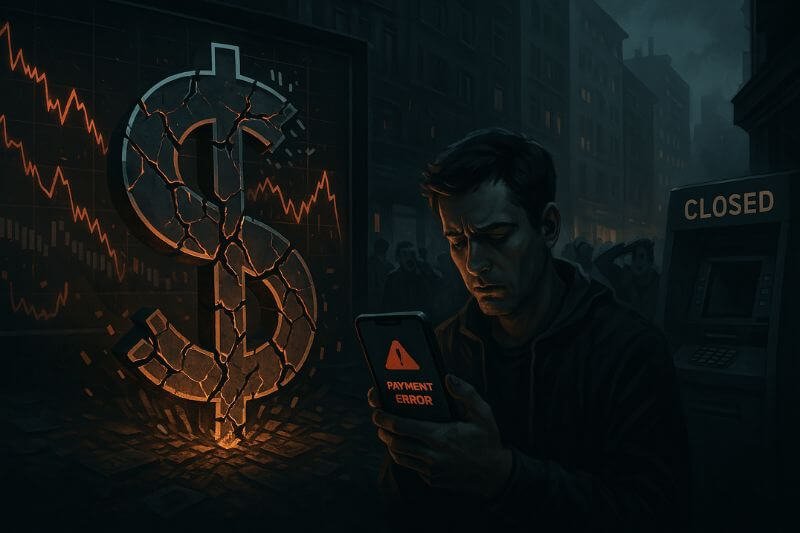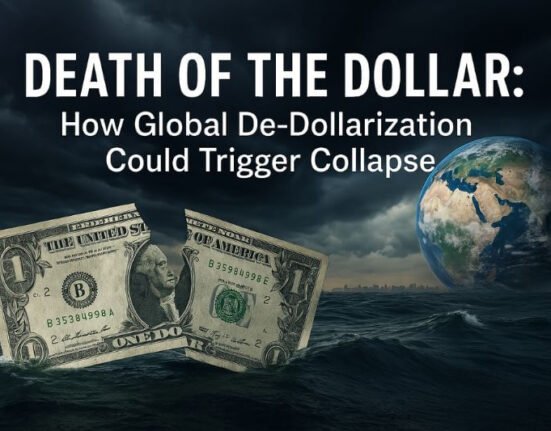A Currency Built on Code—and Risk
As nations race to digitize their currencies, the concept of a cashless society no longer belongs to science fiction. The United States has pushed forward with research into a Central Bank Digital Currency (CBDC)—the so-called “digital dollar.” But what happens if this digital transformation fails?
A growing number of economists, cybersecurity experts, and survivalists warn of the unthinkable: a potential digital dollar collapse. This isn’t just a technical problem—it could ripple across global markets, devastate daily life, and ignite geopolitical instability. In this article, we’ll explore what a digital dollar collapse might look like, why it matters, and how to prepare for the worst.
What Is the Digital Dollar?
Understanding CBDCs
The digital dollar is a proposed form of central bank digital currency (CBDC) issued and backed by the U.S. Federal Reserve. Unlike cryptocurrencies like Bitcoin or Ethereum, which are decentralized and volatile, a CBDC is centralized and designed to act as an official replacement or complement to physical cash.
A New Monetary Architecture
In theory, CBDCs offer benefits like faster transactions, reduced fraud, and easier monetary policy implementation. But this digital architecture also introduces vulnerabilities—technical, political, and economic—that paper currency never had to face.
Signs of a Growing Global Shift to Cashless
- China has already launched its e-CNY (digital yuan) in dozens of cities.
- The European Central Bank is developing the digital euro.
- The U.S. Federal Reserve published a detailed whitepaper on the digital dollar in 2022.
- Sweden and Nigeria have real-world CBDCs already functioning.
But while these initiatives suggest innovation and progress, they also reveal a dangerous centralization of control, and the elimination of private, untraceable transactions.
How Could a Digital Dollar Collapse Happen?
A digital dollar collapse could unfold through various scenarios—some technical, others political or economic. Here are some of the most likely paths:
1. Cyberattacks on National Infrastructure
Digital systems can be hacked, corrupted, or held ransom. A state-sponsored cyberattack targeting the Federal Reserve’s digital infrastructure could paralyze financial transactions, ATM networks, and digital wallets—effectively freezing the economy.
2. Technical Glitches or Code Failures
Even without malicious intent, software bugs or blockchain faults could trigger massive transaction failures. Imagine a system update that accidentally deletes user wallets or duplicates funds. Public trust would collapse instantly.
3. Political Abuse of Power
A fully digital currency could allow unprecedented surveillance and control. What happens when a government decides to “freeze” certain accounts, impose automated fines, or track every purchase in real time? This risk alone could push citizens toward rebellion or alternative black markets.
4. Economic Shocks
A digital dollar would be deeply integrated into global markets. If a major economy defaults, suffers hyperinflation, or undergoes civil unrest, the shock could spread instantly through digital financial systems, triggering a chain reaction of global economic instability.
Global Consequences of a Digital Dollar Collapse
Collapse of Global Trade
The U.S. dollar is the world’s primary reserve currency. If its digital version collapses, international trade could seize up overnight. Without confidence in U.S. transactions, oil markets, commodities, and currency exchanges could crash violently.
Loss of Trust in All Digital Currencies
Even CBDCs in other countries would come under suspicion. The collapse of the digital dollar might lead to a global loss of faith in digital currencies, forcing a hasty retreat back to physical cash—or chaotic alternatives like bartering, crypto, or gold.
Social Chaos in a Cashless Society
In a fully cashless world, the collapse of the digital infrastructure would leave people unable to buy food, fuel, or medicine. Payment terminals would stop working. Bank apps would fail. Chaos would erupt within hours.
Survival Implications: How to Prepare for a Digital Dollar Collapse
If you’re reading this, you’re likely not just interested in the theory—you want to be ready. Here’s how to prepare for a digital dollar collapse with actionable survival strategies:
1. Diversify Your Wealth
Don’t put all your eggs in the digital basket. Convert part of your savings into:
- Physical cash
- Gold or silver coins
- Cryptocurrency wallets (offline hardware wallets recommended)
- Tangible goods (food, tools, fuel, medicine)
2. Build a Local Barter Network
If national currencies collapse, local barter systems will fill the void. Start building trust and exchanging goods or services within your community today.
3. Strengthen Your Digital Defenses
Use password managers, secure email, 2FA authentication, and offline backups for important data. If your digital assets are compromised during a cyberattack, you need to maintain control over essential information.
4. Prepare for a Grid-Down Economy
If the financial system goes down, so will most digital systems tied to it. Invest in:
- Off-grid power (solar, batteries)
- Manual tools (can openers, water pumps)
- Offline resources (printed maps, paper ledgers, manuals)
5. Secure Access to Food and Water
Supply chains may halt if digital systems crash. Keep a stockpile of:
- Non-perishable foods (minimum 30-day supply)
- Water storage or purification systems
- Seeds for growing food locally
Could Governments Recover From a Collapse?
Emergency Protocols Are Lacking
While central banks have contingency plans, few have publicly disclosed protocols for a total CBDC failure. Most rely on the assumption that redundancy and encryption will prevent collapse.
But as we’ve seen with cyberattacks (Colonial Pipeline, SolarWinds) and major outages (Facebook, Amazon Web Services), no system is immune.
Civil Unrest and Martial Law
A major digital dollar collapse could trigger widespread protests, looting, and panic. In extreme cases, the U.S. government may declare martial law to regain control, restrict travel, and suspend civil liberties.
What Role Will Cryptocurrencies Play?
Cryptocurrencies like Bitcoin and Ethereum may benefit from a CBDC failure—temporarily. But they come with their own risks: volatility, regulation, and scalability.
Still, private cryptocurrencies may act as a backup system for trade, especially in peer-to-peer transactions. Building competency in crypto tools now could offer a strategic advantage in the event of a government digital failure.
Hope for the Best, Prepare for the Worst
The idea of a digital dollar collapse isn’t just theoretical—it’s a growing concern among economists, survivalists, and cybersecurity experts alike. While CBDCs offer benefits, their implementation without robust failsafes could unleash financial chaos.
Survival in such a scenario doesn’t depend on wealth or tech skills—it depends on foresight, diversification, local resilience, and knowledge. By preparing today, you increase your chances of thriving when the system you rely on every day suddenly fails.















